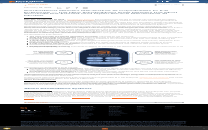
SambaNova Systems
Founded Year
2017Stage
Secondary Market | AliveTotal Raised
$1.132BMosaic Score The Mosaic Score is an algorithm that measures the overall financial health and market potential of private companies.
-13 points in the past 30 days
About SambaNova Systems
SambaNova Systems specializes in enterprise-scale artificial intelligence (AI) platforms and operates within the artificial intelligence and machine learning sectors. The company offers products designed for the development, training, and deployment of AI models, including generative AI and large language models. SambaNova's solutions cater to various sectors, such as the public sector and scientific research. It was founded in 2017 and is based in Palo Alto, California.
Loading...
SambaNova Systems's Product Videos

ESPs containing SambaNova Systems
The ESP matrix leverages data and analyst insight to identify and rank leading companies in a given technology landscape.
The AI training processors market focuses on specialized hardware optimized for deep learning model training workloads. These processors include graphics processing units (GPUs), application-specific integrated circuits (ASICs), and other architectures designed to accelerate complex AI computations. The processors enhance training speed, energy efficiency, and scalability for increasingly sophisti…
SambaNova Systems named as Outperformer among 12 other companies, including Cerebras, Advanced Micro Devices, and Fujitsu.
SambaNova Systems's Products & Differentiators
SambaNova Suite
SambaNova platform consisting of the SambaNova DataScale hardware powered by the SN40L RDU, the SambaStudio software for intuitive model fine tuning and management, and the unique SambaNova model architecture that enables many models to work together as one for increased accuracy and performance.
Loading...
Expert Collections containing SambaNova Systems
Expert Collections are analyst-curated lists that highlight the companies you need to know in the most important technology spaces.
SambaNova Systems is included in 4 Expert Collections, including Unicorns- Billion Dollar Startups.
Unicorns- Billion Dollar Startups
1,287 items
Conference Exhibitors
5,302 items
AI 100 (All Winners 2018-2025)
100 items
Artificial Intelligence
10,402 items
SambaNova Systems Patents
SambaNova Systems has filed 250 patents.
The 3 most popular patent topics include:
- parallel computing
- computer memory
- instruction processing

Application Date | Grant Date | Title | Related Topics | Status |
|---|---|---|---|---|
7/5/2023 | 4/8/2025 | Parallel computing, Free compilers and interpreters, Gate arrays, Integrated circuits, Reconfigurable computing | Grant |
Application Date | 7/5/2023 |
|---|---|
Grant Date | 4/8/2025 |
Title | |
Related Topics | Parallel computing, Free compilers and interpreters, Gate arrays, Integrated circuits, Reconfigurable computing |
Status | Grant |
Latest SambaNova Systems News
Sep 2, 2025
Data centers have long been the backbone of business operations, powering everything from internal systems to customer-facing apps. However, with rising data demands, ageing infrastructure, and growing pressure to cut emissions, the traditional data center model is reaching its limits. Enter cloud computing. In addition to its potential to support high-performance compute (HPC) demands, the cloud is increasingly central to how organizations are rethinking their data center strategies, not just to save money, but to operate more flexibly and sustainably. Cloud integration: Cutting costs and complexity Operating a traditional on-premises data center is expensive. Businesses must pay for hardware, cooling, real estate, maintenance, and skilled staff. And these premises are often sized for peak demand, which means a significant percentage of server capacity often goes unused. Cloud computing offers an alternative. By integrating cloud services with existing data center operations, businesses can scale up or down as needed, paying only for what they use. To fully unlock these cost benefits, businesses must adopt FinOps practices: the discipline of bringing engineering, finance, and operations together to optimize cloud spending. Without it, cloud costs can quickly spiral, especially in hybrid environments. But, with FinOps, organizations can forecast demand more accurately, optimise usage, and ensure every pound spent delivers value. The Energy & Sustainability Supplement Towards a greener future 02 May 2025 Sustainability: The other cloud advantage While cost efficiency is a powerful motivator, sustainability has become an equally urgent priority. Data centers are major energy consumers; in fact, the International Energy Agency (IEA) found that data centers and data transmission networks account for an estimated one to 1.5 percent of global electricity use. Cooling systems alone can represent nearly 40 percent of that. And demand is only growing. The IEA projects that electricity use from data centers could more than double by 2030, reaching around 945 terawatt-hours (TWh). That's more than the entire electricity consumption of Japan today. Cloud providers, especially hyperscalers like AWS, Microsoft Azure, and Google Cloud, are leading the charge in sustainable innovation. They're investing heavily in green infrastructure, renewable energy, efficient cooling, and low-power hardware. By offloading energy-intensive workloads to the cloud, companies can reduce the load on their on-premises facilities, cutting local power consumption and cooling demands. That means fewer emissions, longer hardware lifespans, and less electronic waste. Cloud platforms make it easier to use computing resources more efficiently. Even though the infrastructure stays online, hyperscalers can spread workloads across many customers, keeping their hardware busier and more productive. The advantage is that hyperscalers can distribute workloads across multiple customers and manage capacity at a large scale, allowing them to power down hardware when it's not in use. Compared to traditional data centers that often-run underused servers around the clock, this shared model leads to better energy efficiency overall. Cloud and AI: Optimizing data center performance The combination of cloud computing and artificial intelligence (AI) is further reshaping data center operations. AI can analyse energy usage, detect inefficiencies, and recommend real-time adjustments. But running these models on-premises can be resource-intensive. Cloud-based AI services offer a more efficient alternative. Take Google, for instance. By applying AI to its data center cooling systems, it cut energy use by up to 40 percent. Other organizations can tap into similar tools via the cloud to monitor temperature, humidity, and workload patterns and automatically adjust cooling, load balancing, and power distribution. The result? Smarter operations, lower costs, and a smaller environmental footprint. Key considerations for cloud-enabled data center transformation Of course, moving to the cloud doesn't happen overnight. Migration takes planning, investment, and long-term change management. So, what must businesses consider as they begin their cloud transformation journey? Start small and strategic. Focus on non-sensitive workloads, such as backups, disaster recovery, or new workloads such as AI analytics. These quicker wins can help build momentum for broader transformation. Make the most of the resources available to you. Many cloud providers offer incentives like migration credits, discounted pricing, and advisory support to ease the transition. And don't forget FinOps. Cloud integration isn't a one-off project; it's an ongoing process that requires continuous monitoring and collaboration across teams to stay on track. A hybrid future The future of data centers isn't 100 percent cloud or 100 percent on-premises: it's hybrid. Cloud computing gives organizations the flexibility to scale, the tools to optimise, and the opportunity to operate more sustainably. By combining cloud technologies with strong financial governance and a focus on sustainability, businesses can turn their data centers from static cost centers into agile, efficient, climate-conscious assets. It's not just about saving money, it's about building a smarter, greener digital future. Subscribe to The Cloud & Hybrid Channel for regular news round-ups, market reports, and more. Create an Account to Subscribe Now More in Cloud & Hyperscale The state of data and AI in Europe 07 Mar 2025 SambaNova partners with SoftBank to expand its AI cloud throughout APAC 02 Apr 2025 OVH and Luxembourg Post to launch sovereign cloud offering More in Sustainability Data centers: Energy efficiency and management 28 Mar 2025 Meta-backed solar project goes live in Texas Episode From design to decommissioning - Managing the data center lifecycle
SambaNova Systems Frequently Asked Questions (FAQ)
When was SambaNova Systems founded?
SambaNova Systems was founded in 2017.
Where is SambaNova Systems's headquarters?
SambaNova Systems's headquarters is located at 2200 Geng Road, Palo Alto.
What is SambaNova Systems's latest funding round?
SambaNova Systems's latest funding round is Secondary Market.
How much did SambaNova Systems raise?
SambaNova Systems raised a total of $1.132B.
Who are the investors of SambaNova Systems?
Investors of SambaNova Systems include CrossWork, Google Ventures, Walden International, Intel Capital, BlackRock and 13 more.
Who are SambaNova Systems's competitors?
Competitors of SambaNova Systems include OpenAI, Rebellions, Rain AI, d-Matrix, Groq and 7 more.
What products does SambaNova Systems offer?
SambaNova Systems's products include SambaNova Suite and 1 more.
Who are SambaNova Systems's customers?
Customers of SambaNova Systems include Blackbox and Texas Advanced Computing Center.
Loading...
Compare SambaNova Systems to Competitors

Groq specializes operates as an AI inference technology within the semiconductor and cloud computing sectors. The company provides computation services for AI models, ensuring compatibility and efficiency for various applications. Groq's products are designed for both cloud and on-premises AI solutions. It was founded in 2016 and is based in Mountain View, California.

FuriosaAI focuses on designing AI accelerators for the AI and computing industry. The company provides AI accelerators for large language models, multimodal applications, and computer vision, with a focus on AI inference performance in data centers. FuriosaAI serves sectors that require AI processing capabilities, including the enterprise and cloud computing industries. It was founded in 2017 and is based in Seoul, South Korea.

ChipIntelli operates in the intelligent voice chip industry and focuses on providing solutions for more natural, simple, and smart human-machine interactions. The company offers a range of intelligent voice chips and solutions that cater to various applications, including offline voice recognition and voice-enabled smart devices. ChipIntelli's products are primarily used in the smart home appliances, smart lighting, smart automotive, and smart education/entertainment sectors. It was founded in 2015 and is based in Chengdu, China.

Tenstorrent is a computing company specializing in hardware focused on artificial intelligence (AI) within the technology sector. The company offers computing systems for the development and testing of AI models, including desktop workstations and rack-mounted servers powered by its Wormhole processors. Tenstorrent also provides an open-source software platform, TT-Metalium, for customers to customize and run AI models. It was founded in 2016 and is based in Toronto, Canada.

Mythic is an analog computing company that specializes in artificial intelligence (AI) acceleration technology. Its products include the M1076 Analog Matrix Processor and M.2 key cards, which provide power-efficient AI inference for edge devices and servers. Mythic primarily serves sectors that require real-time analytics and data throughput, such as smarter cities and spaces, drones and aerospace, and augmented reality (AR) or virtual reality (VR) applications. Mythic was formerly known as Isocline Engineering. It was founded in 2012 and is based in Austin, Texas.

Cerebras focuses on Artificial Intelligence (AI) acceleration through its development of wafer-scale processors and supercomputers for different sectors. The company provides computing solutions that support deep learning, natural language processing, and other AI workloads. Cerebras serves industries including healthcare, scientific computing, and financial services with its AI supercomputers and model training services. It was founded in 2015 and is based in Sunnyvale, California.
Loading...
